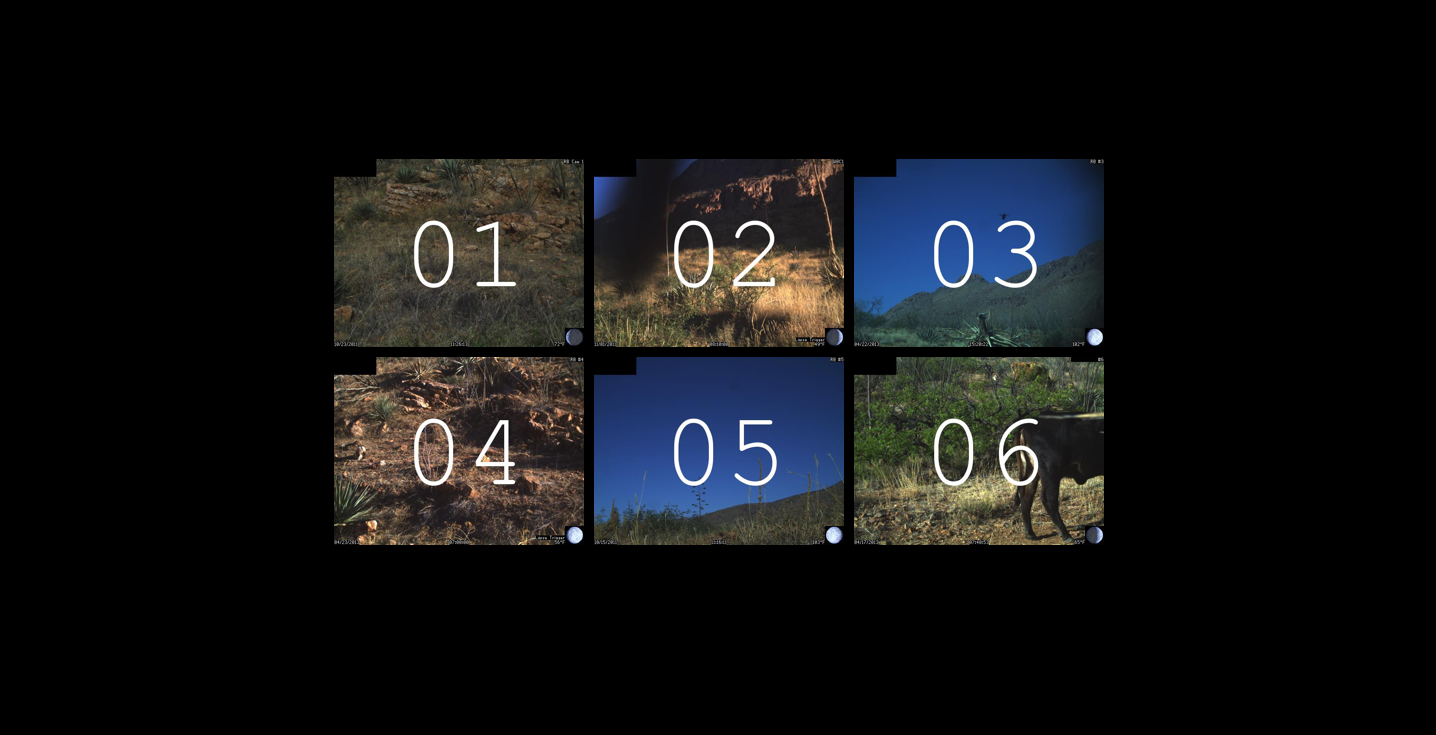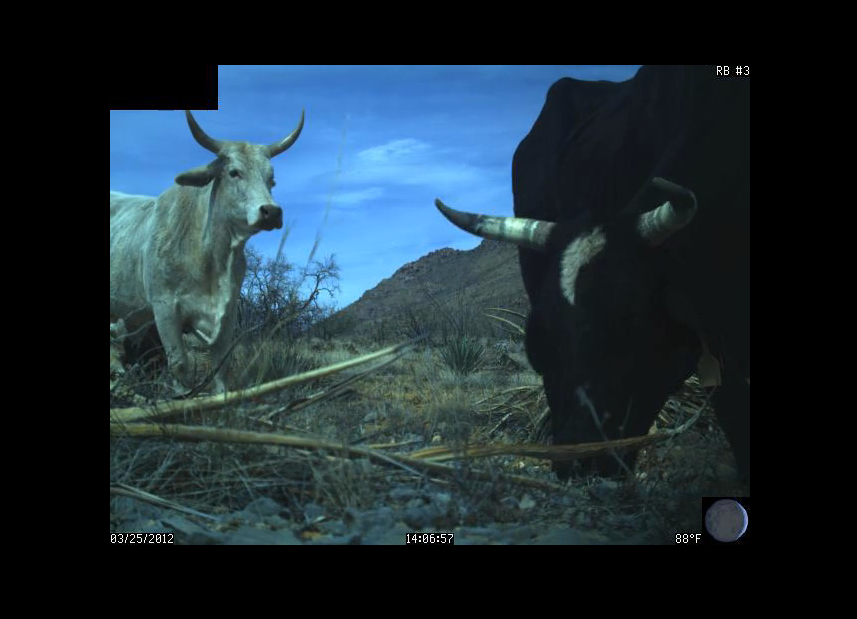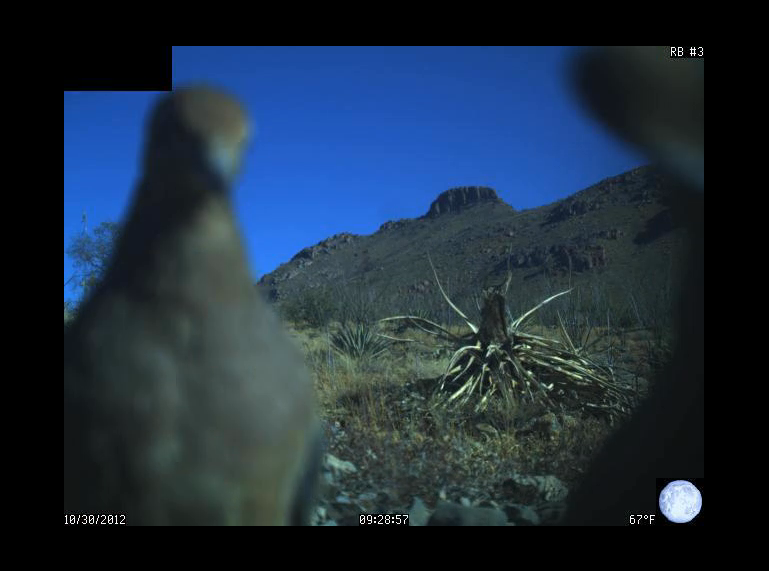Joana Moll
Independent Artist
Introduction
My work examines the rapid spread of visual information across networked technologies. In particular, I am interested in the social and political stakes of interactive surveillance systems used to police the US-Mexico Border. Online, participatory surveillance platforms now allow ordinary citizens to surveil the national border from their own homes. These platforms were adopted as low cost, pervasive ways of monitoring the border by offloading the state’s responsibility to secure the territory to the citizens. The networking and virtualizing of border patrols, I argue, acts as a mechanism to reduce control over democratic processes. My research into networked surveillance has resulted in two net-based artworks: The Texas Border [1] and AZ: move and get shot. [2] While The Texas Border explores the civilian use of online surveillance infrastructure provided by a publicly funded organization to monitor the border, AZ: move and get shot reveals how surveillance is performed as a private initiative. The pieces address virtual surveillance through different viewpoints: the human one, in The Texas Border; and the technological one, in AZ: move and get shot. However, they both point towards a possible militarization of civil society through the use of web-based cameras to watch immigrants crossing the border. When combined with interactive media, virtual surveillance becomes a tool to decontextualize the border and crowdsource the police actions to civilians, and, by extension, turn the users into disengaged border officers.
The Texas Border and AZ: move and get shot, represent visible manifestations of the acceleration of human society, a phenomenon Paul Virilio termed “Dromology.” [3] This continuous increase in the compression of time within contemporary techno-society, “has had largely detrimental consequences with the decline of the public sphere, the erosion of the democratic process and the increased power of the military complex.” [4]
AZ: move and get shot is an on-going Internet-based artwork that shows the actions occurring on the US border in Arizona through the perspective of six surveillance cameras. The piece went live on June 2012, and continues to run today. The cameras are part of an online platform called Wireless Border Cams (WBC), [5] created by a group of landowners with properties near the U.S. border. The main purpose of this group is to provide the public with raw images of immigrants crossing the border illegally through their lands, so they can report the events to the local authorities. The platform asks the users for private donations in order to extend the private virtual fence network. Each camera incorporates a motion sensor, which triggers the capture of images when it detects the slightest vibration of the landscape. Then these captured images are sent to a server and displayed directly on the WBC web page.
The WBC surveillance interface allows the user to choose between three cameras (originally six). The page then displays 300 of the most recent pictures shot by the selected camera. At that point, the user is ‘invited’ to check the images and share them on Facebook. Although I was ‘free’ to navigate through all the images without the need to carry out any particular task, I felt compelled to find images of immigrants crossing the border.
My piece is composed of six independent films automatically composed of the images captured by each camera. Every 24 hours, a script detects whether new pictures coming from the cameras have been uploaded. These new images are saved to my local server and added algorithmically after the last frame of the corresponding video. Thus, the films expand and reveal, day by day, the pace and the nature of the movement of the Arizona border territory.
While the main goal of the landowners is to capture and disseminate photographs of immigrants entering the United States illegally, the camera is programmed to detect and record any movement. By delegating surveillance to a machine, human intention is lost, and the original purpose is transformed, resulting in an accelerated collection of images, which reveal not only immigrants, but all kinds of human, animal and natural activity. Therefore, I conceived AZ: move and get shot with the intention to reveal how this action of monitoring the border becomes something uncontrollable and potentially meaningless.
Andrew Feenberg argues that ‘the values of a specific social system and the interests of its ruling classes are installed in the very design of the rational procedures of machines’. Thus, “values and interests turn into rules and procedures. Devices and machines routinize the pursuit of power.” [5] Despite the low efficiency of the monitoring activity, the landowners insist on performing the surveillance. At this point, it seems that the landowners act under the logic of the machine by prioritizing action over reflection. Thus, by surrendering to the rational procedures of the cameras, which have been prescribed beforehand, the virtual watchers reproduce and legitimize existent power dynamics.
The Texas Border draws its content from Texas Virtual BorderWatch (TBW): a public-private partnership to deploy the Virtual Community Watch, an innovative real-time surveillance program designed to empower the public to proactively participate in fighting border crime. [6] TBW was launched in 2008. The platform consisted of an online platform called BlueServo and a network of 200 cameras and sensors located in strategic areas along the US Mexico border. Some of these cameras were also installed in the private properties of volunteering citizens. The BlueServo site gave free access to cameras broadcasts 24/7, and allowed users to report anonymously if they noticed any suspicious activity on the border. BlueServo had 203,633 volunteer users since the platform was launched in 2008, and resulted in 5331 interdictions, which overall represents almost 1 million hours of free labor for the Sheriff. [7] The program stopped in 2012 due to lack of financial support, as announced on its official Facebook page on May 13 2012. [8].
BlueServo’s user-interface consisted of two live camera feeds from which the user could select any of the 25 available cameras. Under each feed there were three buttons: “Make a Comment” in green, “Ask a Question” in blue and “Report Suspicious Activity” in red. Below the buttons, there was a detailed set of instructions on how to execute the surveillance depending on the selected camera. For instance, indications for camera 1 were: “This area is known of illegal drug activity. If you see people crossing the river via foot or raft in this area please report activity.” [9] Even though I was morally against the purposes of the site, when something would move, or human activity would appear, I felt compelled to press the red button. Once immersed in the logic, and by extension, the rules of the site, it felt like the right thing to do. To think did not seem to be an option, at least before taking an action. A comment conversation between two BlueServo users, found on the BlueServo Facebook page, best represents this idea. “I saw lots of activity about an hour ago,” reports one user, “ several people moving back & forth between the white building and the river bank.” “I hope none of them got to the US!! Do you think it might be drug dealers?” “I don’t know. I reported it, then I thought maybe they’re just fishing.” [10]
I presented The Texas Border as an online audio-visual installation, which broadcasted original recorded video feeds captured by the BlueServo cameras. The installation also included sixty-four videos, which were taken from BlueServo’s publicly accessible archive. The videos showed incursions into the US territory, which failed as a direct consequence of the reports carried out by anonymous BlueServo users. The piece also displayed detailed instructions, provided by BlueServo, which carefully explained to users how to carry out the surveillance on each camera. The project presented these orders algorithmically through text in the videos. This staging allowed us to emphasize the human presence behind the act of monitoring, and thus, to stress the existence of a specific interest which conducted the users to perform certain actions. In that sense, the users were also surveilled. In addition, this setup enhanced the power of technical action to transfer the authority exercised by the invisible human operator towards the viewer.

Fig. 4. The Texas Border, 2010, Joana Moll & Heliodoro Santos, digital media, image: Eugenio Tisselli (Used with permission).
Due to the lack of reliable data from BlueServo and WBC on the number of detentions accomplished by the authorities as a direct consequence of the reports carried out through this their platforms, it is difficult to determine the efficiency of these initiatives to stop criminal activity or block illegal immigration from entering the US. Nevertheless, the effort seemed quite effective at keeping citizens monitoring the border.
There are complex cultural, political, and economic explanations for why citizens ‘freely’ engage in this kind of practice, including its context as taking place within a the culture of fear. [11] Nonetheless, as I previously explained, during the conception of AZ: move and get shot and The Texas Border, my interest focused on computer-mediated interactivity as I believe the user’s actions may have been highly predetermined by the platform.
Interactivity, according to Lev Manovich, “defines and reconstitutes users as subjects of ideology.” [12] In other words, interactivity represents a form of interpellation that embodies a higher level of authority that users reproduce by willingly subjecting themselves to the rules of the interaction. In addition, interactive media ask us to identify with someone else’s mental structure. [13] In the BlueServo and WBC case, the user is expected to act as a border officer. Moreover, the user yields his private space and free time to secure the country.
In an accelerated environment, Paul Virilio argues, the slower subject is constantly being dominated by the faster one. [14] The BlueServo and WBC users, therefore, are repeatedly dominated by the technological infrastructure in which they operate: an accelerated environment that compresses the user’s time to perceive and prescribe the actions she takes. In this scenario, the user is not required to think, just to act under a set of specific preconceived conditions. BlueServo and WBC initiatives reveal how technology can act as a dark entity that prescribes social behaviour to reproduce existent structures of power that favor the ruling classes.
During the time I was a user of BlueServo and WBC, I felt caught in an opaque system where understanding and thinking became difficult exercises. I felt it was crucial to build a space in order to contemplate the mechanisms by which these platforms operated.
Appropriating the camera feeds of BlueServo and WBC allowed me to decontextualize the images from their original sources, and thus to suspend them in an interactivity-free and apparently neutral setting, with the aim of turning these images into objects of thinking and reflection. Therefore, I believe that in the process of separating the sources of the camera feeds from their original contexts, the images can become weapons capable of revealing the mechanisms of a complex techno-social system, which, due to its accelerated nature, erodes the democratic dialogue as a means to the legitimate exercise of power.
Yet, BlueServo and WBC unveil another dangerous aspect of technology – the dilution of responsibility of individual actions. This dilution allows users to create comfortable ‘guilt-free’ environments where they can fully concentrate on acting, thus avoiding reflection.
I have not attempted to come up with conclusions, but to present a series of established techno-social mechanisms that I believe need urgent reconfiguration, as they seriously marginalize the human capacity to think.
References
1. The Texas Border, 2010, accessed April 15, 2014, http://www.janavirgin.com/texas.html
2. AZ: Move and get shot, 2012 – 2014, accessed April 15, 2014, http://www.janavirgin.com/AZ/
3. Wireless Border Cams official Web Site, accessed April 15, 2014, http://www.wirelessbordercams.com/
4. BlueServo official Web Site, accessed April 2010, http://www.blueservo.net/
5. Doug Tewksbury “Crowdsourcing Homeland Security: The Texas Virtual BorderWatch and Participatory Citizenship”, Surveillance and Society 10, no. 3/4 (2012): 249-262.
6. BlueServo official Web Site, accessed September 2013, http://www.blueservo.net/
7. BlueServo Facebook page, May 13, 2012, accessed August 2012, https://www.facebook.com/pages/BlueServo/184484348271281
8. BlueServo official Web Site, accessed April 2010, http://www.blueservo.net/
9. BlueServo Facebook page, December 5, 2010, accessed December 2010, https://www.facebook.com/pages/BlueServo/184484348271281
10. Hille Koskela “Watch the Border 24/7, on your couch: Texas Virtual Border Watch Program and the politics of informing”, Vigilância, Segurança e Controle Social na América Latina, Curitiba, 2009.
11. Matt Garite, The ideology of interactivity (or, video games and the taylorization of leisure) Level Up, Digital Games Research Association, Jan 1, 2003.
12. Lev Manovich, as quoted in Matt Garite, “The ideology of interactivity (or, video games and the taylorization of leisure)” Level Up, Digital Games Research Association, Jan 1, 2003, 5.
13. Paul Virilio, Speed and Politics: An Essay on Dromology (Semiotext(e)), 1977.
14. Andrew Feenberg, Transforming Technology: A Critical Theory Revisited(Oxford: University Press, 2002), 14.
15. Rob Bartram “Visuality, Dromology and Time Compression : Paul Virilio’s New Ocularcentrism,” Time Society no. (2004): 285.
Bio
Born in Barcelona in1982, Joana Moll holds a Master’s degree in Digital Arts from the Universitat Pompeu Fabra and a BA in Visual Arts from the Universitat Autònoma de Barcelona, Spain. She has performed and exhibited her work internationally in venues such as Arts Santa Monica and The Picasso Museum, Barcelona; Ithaca College, New York; Oi Futuro Institute, Rio de Janeiro; Albuquerque Museum of Art and History, New Mexico; Lancaster University, Lancaster; Musée des Tapisseries, Aix-en-Provence; Museum of Contemporary Art of Vojvodina, Serbia; Ammerman Center for Arts and Technology, Connecticut. She took part in FILE 2011 held in Sao Paulo and FILE 2012 in Rio de Janeiro, Brazil; ISEA 2012 edition in New Mexico (United States) and Festival Internacional de la Imagen 2013 in Manizales, Colombia. She is actively collaborating with Sauti ya wakulima project and is a member of the Scientific and Artistic Committee of the Antiatlas des Frontières.
http://janavirgin.com





